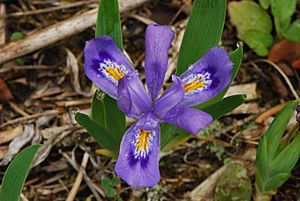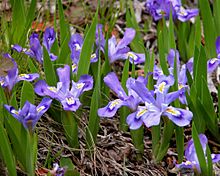Dwarf lake iris facts for kids
Quick facts for kids Dwarf lake iris |
|
|---|---|
 |
|
| Conservation status | |
| Scientific classification | |
| Genus: |
Iris
|
| Species: |
lacustris
|
| Synonyms | |
|
|
The dwarf lake iris (Iris lacustris) is a special plant found in the Great Lakes region of North America. It belongs to the Iris family. This plant grows from a special underground stem called a rhizome. It is a perennial plant, meaning it lives for more than two years.
The dwarf lake iris has pretty lavender blue or violet-blue flowers. Its stem is very short, and its green leaves are long and shaped like a fan. People sometimes grow it in their gardens because it is so beautiful. It is very similar to another iris called Iris cristata.
Contents
About the Dwarf Lake Iris
The dwarf lake iris looks a lot like Iris cristata, but it is smaller. It also has a different number of chromosomes, which are tiny parts inside cells that carry genetic information.
How it Grows: Rhizomes and Leaves
This iris has thin, greenish-brown or yellow rhizomes. These rhizomes are like underground stems that spread out. They help the plant creep along the ground and form thick groups of plants.
The plant has 8 to 12 green leaves that grow from its base. They are shaped like a fan or a sword. These leaves are usually about 4 to 6 centimeters (about 2 inches) long. After the flowers bloom, the leaves can grow even longer, up to 15 to 16 centimeters (about 6 inches).
Sometimes, when the iris is not flowering, its leaves can be mistaken for another plant called false asphodel (Triantha glutinosa). However, the false asphodel's flower stem is much longer and very sticky.
Its Flowers and Stems
The dwarf lake iris has very short stems, only about 0.8 to 5 centimeters (less than 2 inches) long. This means the flowers and stems are shorter than the leaves.
The plant has green spathes, which are like special leaves that protect the flower bud. These spathes are about 3 to 4.5 centimeters long.
Each short stem usually has one or two flowers. These flowers bloom in spring, usually in April, May, or early June. Sometimes, they can even have more flowers in the fall, around October. The dwarf lake iris often blooms a week or two earlier than Iris cristata.
The flowers are about 4 to 6 centimeters (about 2 inches) wide. They come in different shades of blue, like sky blue, deep blue, lavender blue, or lilac. Very rarely, you might find a white flower.
Each flower has two types of petals. There are three large outer petals called 'falls'. These falls are about 2 to 2.3 centimeters long. They have a white patch with a dark violet edge. In the middle of this patch, there are three orange, gold, or yellow ridges that look like teeth. This patch helps guide bumblebees to the center of the flower to help with pollination. There are also three smaller inner petals called 'standards'. These are shorter and narrower than the falls.
After the flower blooms, usually from late June to late July, the plant makes a round or oval seed capsule. Inside, there are dark brown seeds that are about 3 millimeters wide. These seeds have a special white, spiral-shaped part called an eliaosome. Ants love to eat these eliaosomes because they are full of energy. When ants carry the seeds, they help the plant spread to new places.
Plant Genetics
Scientists have studied the genetic makeup of the dwarf lake iris. They looked at its chromosomes. Most irises have two sets of chromosomes. The dwarf lake iris has been counted with 2n=32 or 2n=42 chromosomes. This information helps scientists understand how different iris plants are related.
Naming the Dwarf Lake Iris
The scientific name for this plant is Iris lacustris. The word lacustris means "of lakes" in Latin, which makes sense because it grows near lakes.
It is also known by common names like dwarf lake iris, lake iris, and Great Lakes iris.
The dwarf lake iris was first discovered on Mackinac Island in 1810 by a botanist named Thomas Nuttall. He wrote about it in a book called 'The Genera of North American Plants' in 1818.
For a long time, some people thought the dwarf lake iris was just a type of Iris cristata. But later studies of their chromosomes showed that they are actually two different species.
Where the Dwarf Lake Iris Lives
The dwarf lake iris is found in cool areas of North America.
Its Home Range
You can find this plant in Canada, specifically in the province of Ontario. In the U.S.A., it grows in the states of Michigan, Wisconsin, and sometimes in Ohio.
It mostly lives on the northern shores and smaller islands of Lake Michigan, Lake Huron, and Lake Superior. Most of these iris plants are found close to the shore, usually within 500 meters (about 1,600 feet) of Lake Huron. Some larger groups can be found a few kilometers away from the lake.
What Kind of Places It Likes
The dwarf lake iris loves to grow on the shorelines of the Great Lakes. It likes cool, moist air from the lake.
It grows in sand or thin soil over limestone-rich gravel. It prefers chalky soil or bedrock. You can also find it in special limestone areas called alvars, along old beach ridges, next to streams, in ditches, on cliffs, behind sand dunes, or at the edges of pine forests.
Protecting the Dwarf Lake Iris
The dwarf lake iris is considered a "vulnerable" threatened species. This means it needs protection from harm. It was added to the U.S. list of endangered and threatened plants in 1988.
It is threatened because its home is being destroyed by things like building new homes along the shoreline, widening roads, using chemicals and salt, and off-road vehicles.
Because it is a protected species, you are not allowed to dig up these plants or collect their seeds without a special permit. This helps make sure the plant can survive and thrive. About 37% of the Canadian dwarf lake iris population lives in protected areas. Sometimes, shoreline development can even help by opening up new areas for the plant to grow.
Growing the Dwarf Lake Iris
This plant is quite tough and can grow in many different places. It can handle cold winters.
It likes moist soil that is a little bit acidic or neutral. It grows best in places that get some sun, but it can also handle full sun.
You can grow it in a special soil mix called peat or in a pot. It is not often sold in Europe. There is a specimen growing in the Cambridge Botanic Garden in the UK.
Is It Safe to Touch?
Like many other iris plants, most parts of the dwarf lake iris are poisonous if eaten. This includes the rhizome and leaves. If someone accidentally eats them, it can cause stomach pains and vomiting. Just touching the plant might also cause skin irritation or an allergic reaction for some people. So, it's best to look but not touch!
Michigan's State Wildflower
In 1998, the dwarf lake iris was chosen as the state wildflower of Michigan. This is a special honor because most of these plants live in Michigan.
Images for kids




